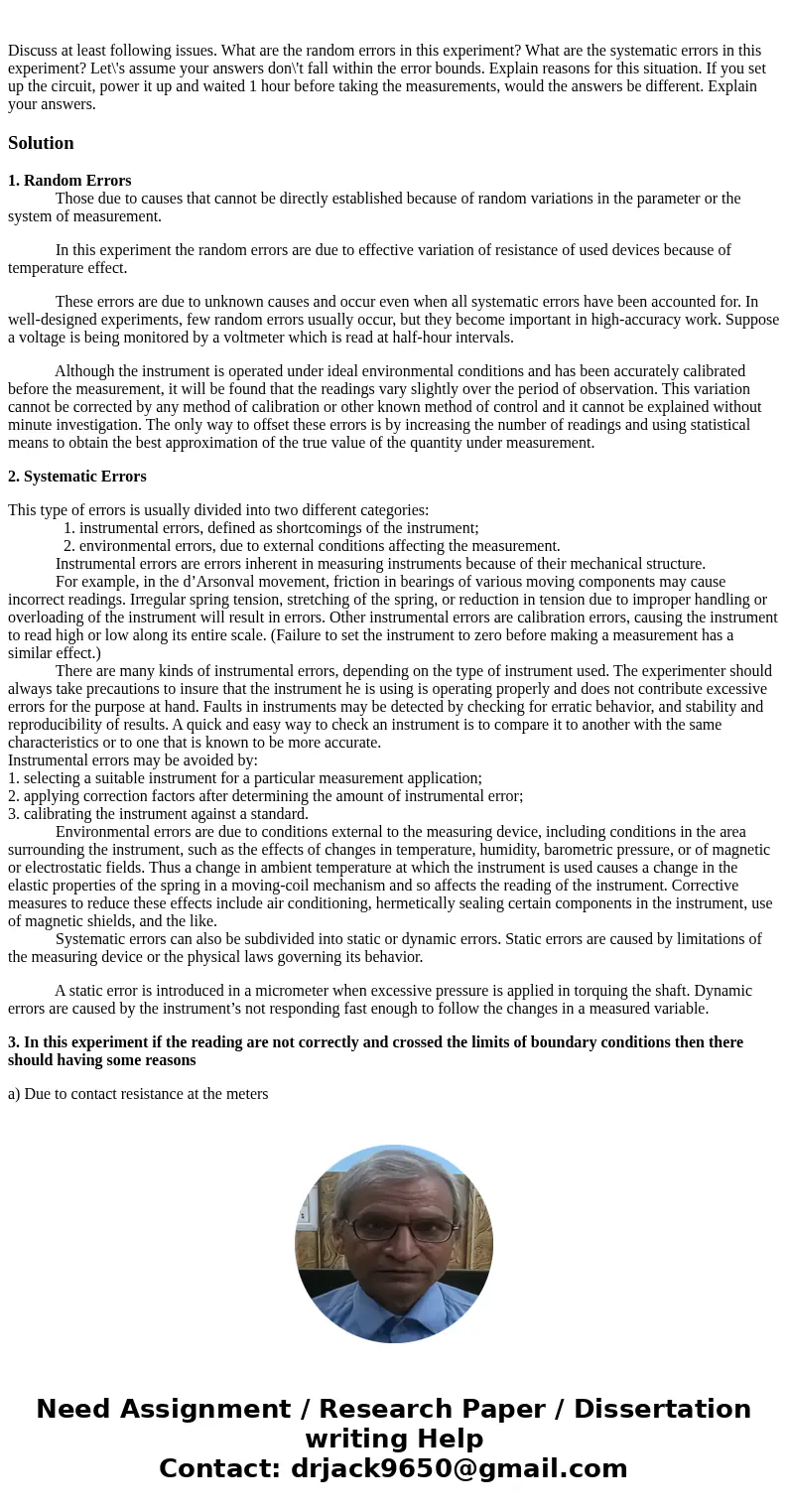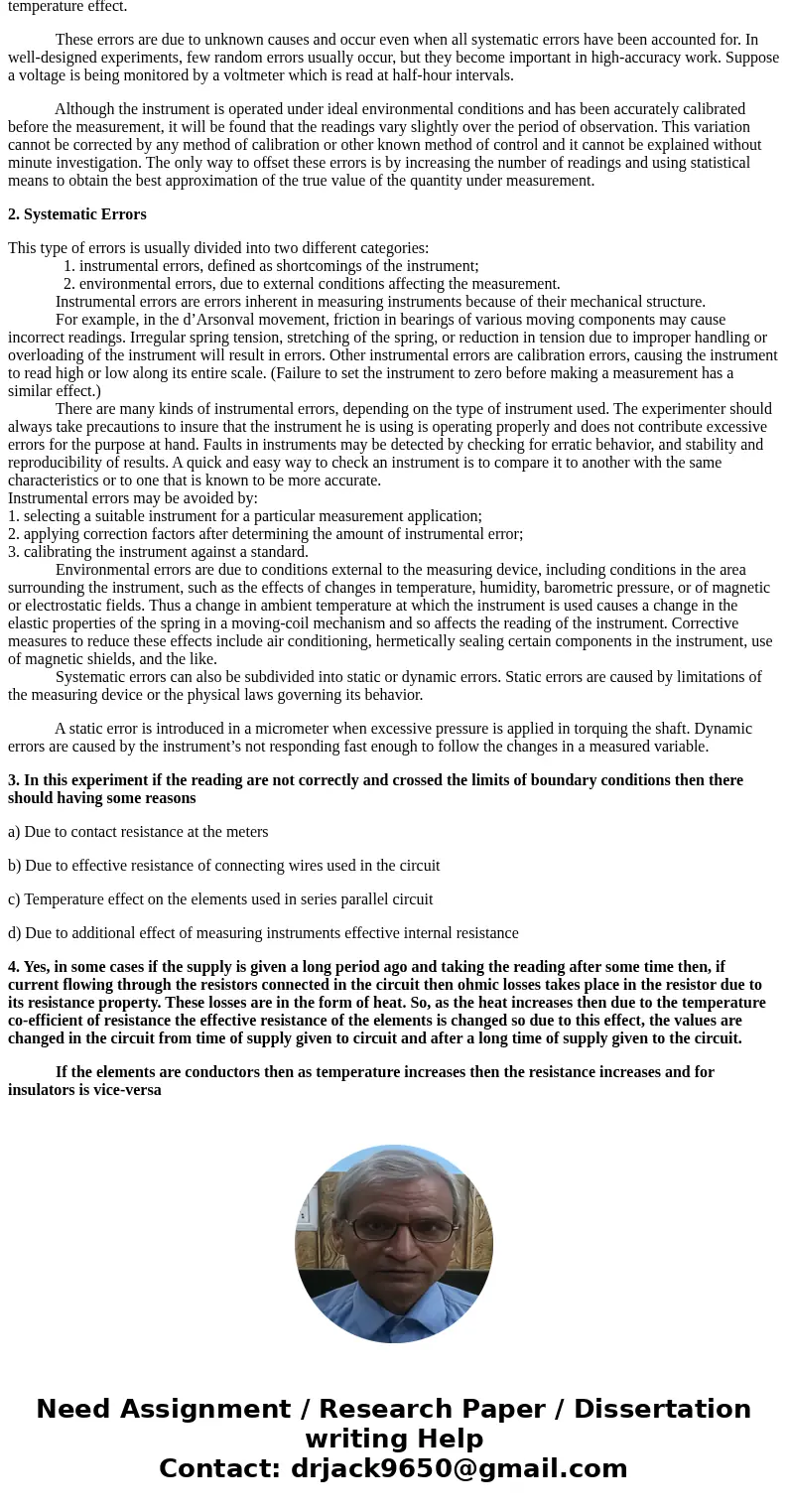Discuss at least following issues What are the random errors
Solution
1. Random Errors
Those due to causes that cannot be directly established because of random variations in the parameter or the system of measurement.
In this experiment the random errors are due to effective variation of resistance of used devices because of temperature effect.
These errors are due to unknown causes and occur even when all systematic errors have been accounted for. In well-designed experiments, few random errors usually occur, but they become important in high-accuracy work. Suppose a voltage is being monitored by a voltmeter which is read at half-hour intervals.
Although the instrument is operated under ideal environmental conditions and has been accurately calibrated before the measurement, it will be found that the readings vary slightly over the period of observation. This variation cannot be corrected by any method of calibration or other known method of control and it cannot be explained without minute investigation. The only way to offset these errors is by increasing the number of readings and using statistical means to obtain the best approximation of the true value of the quantity under measurement.
2. Systematic Errors
This type of errors is usually divided into two different categories:
1. instrumental errors, defined as shortcomings of the instrument;
2. environmental errors, due to external conditions affecting the measurement.
Instrumental errors are errors inherent in measuring instruments because of their mechanical structure.
For example, in the d’Arsonval movement, friction in bearings of various moving components may cause incorrect readings. Irregular spring tension, stretching of the spring, or reduction in tension due to improper handling or overloading of the instrument will result in errors. Other instrumental errors are calibration errors, causing the instrument to read high or low along its entire scale. (Failure to set the instrument to zero before making a measurement has a similar effect.)
There are many kinds of instrumental errors, depending on the type of instrument used. The experimenter should always take precautions to insure that the instrument he is using is operating properly and does not contribute excessive errors for the purpose at hand. Faults in instruments may be detected by checking for erratic behavior, and stability and reproducibility of results. A quick and easy way to check an instrument is to compare it to another with the same characteristics or to one that is known to be more accurate.
Instrumental errors may be avoided by:
1. selecting a suitable instrument for a particular measurement application;
2. applying correction factors after determining the amount of instrumental error;
3. calibrating the instrument against a standard.
Environmental errors are due to conditions external to the measuring device, including conditions in the area surrounding the instrument, such as the effects of changes in temperature, humidity, barometric pressure, or of magnetic or electrostatic fields. Thus a change in ambient temperature at which the instrument is used causes a change in the elastic properties of the spring in a moving-coil mechanism and so affects the reading of the instrument. Corrective measures to reduce these effects include air conditioning, hermetically sealing certain components in the instrument, use of magnetic shields, and the like.
Systematic errors can also be subdivided into static or dynamic errors. Static errors are caused by limitations of the measuring device or the physical laws governing its behavior.
A static error is introduced in a micrometer when excessive pressure is applied in torquing the shaft. Dynamic errors are caused by the instrument’s not responding fast enough to follow the changes in a measured variable.
3. In this experiment if the reading are not correctly and crossed the limits of boundary conditions then there should having some reasons
a) Due to contact resistance at the meters
b) Due to effective resistance of connecting wires used in the circuit
c) Temperature effect on the elements used in series parallel circuit
d) Due to additional effect of measuring instruments effective internal resistance
4. Yes, in some cases if the supply is given a long period ago and taking the reading after some time then, if current flowing through the resistors connected in the circuit then ohmic losses takes place in the resistor due to its resistance property. These losses are in the form of heat. So, as the heat increases then due to the temperature co-efficient of resistance the effective resistance of the elements is changed so due to this effect, the values are changed in the circuit from time of supply given to circuit and after a long time of supply given to the circuit.
If the elements are conductors then as temperature increases then the resistance increases and for insulators is vice-versa


 Homework Sourse
Homework Sourse